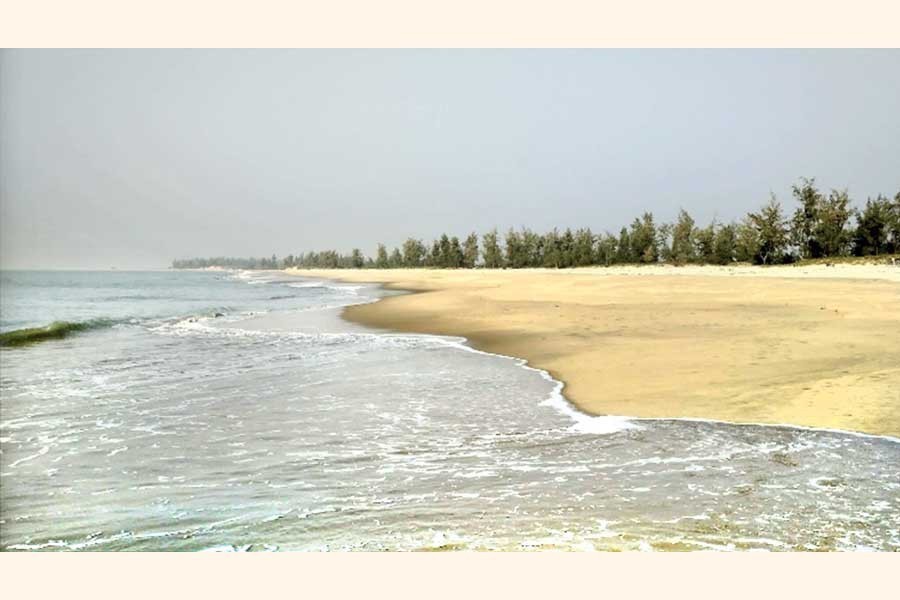
Published :
Updated :

Except the intrepid and obsessively tour-loving people, the city-dwelling general masses still resist the temptation of visiting seaside stretches for recreation. The crowds now seen at popular beaches comprise mostly local people, or those living in the nearby districts. The beaches in the country's southern coastal rim have long opened to public. In the initial days, the crowds were thin. The reason apparently was many were wary of dashing for the beaches at Cox's Bazar, Kuakata or Patenga. They preferred to wait. They wanted to see how the pandemic situation unfolds in the neighbourhoods of the beaches. It was because the mandatory social distance guidelines were seen being defied recklessly by many at the beaches. However, as days wore on and upon being convinced of a satisfactory environment, the hesitant tourists began toying with the idea of visiting the seashores. Many others joined them eventually.
The occasionally enforced local, regional and countrywide shutdowns stood in the tourists' way. Those would mean closure of the movement of inter-district or countrywide transport movement .This hindrance emerged as the firstbrunt of the shutdowns to be borne by the intending tourists. Anti-Covid-19 government measures still deter scores of people from planning days-long tour programmes at the country's beach sites. Or else, they would be seen spending solitary high noon under colourful umbrellas, or crowded afternoons rolling late into the evenings on the crowded beaches. The beaches turn highly crowded on the two Eids and national holidays. During the whole season of winter, the Cox's Bazar and the other two beaches remain filled with tourists. A few venturesome youths visit the beaches during monsoon to enjoy the beauty of the sea amid rains.
In spite of these turnouts of tourists, lots of many cannot muster the financial ability to come to the beaches. Amazingly, they do not have regrets. In fact, they never miss the sea and its stretches of sandy shores. Instead of the sea beaches, they have shores that run along the wide rivers. During monsoon these rivers wear the look of seas --- at times turbulent.Apart from the Meghna, the Padma, the Karnaphuli and the Jamuna, dozens of locally major rivers these days continue to invite leisure-lovers to their banks. In order to facilitate people to take strolls on the riversides, the local administrations in many areas have built concrete walkways punctuated by permanent 'pucca' benches. Many river-shores these days are dotted with snacks and soft drink corners. But they are not crowded like those on the beaches. People of all ages, both male and female --- many attired in their best, give the riverside evenings a festive look. Needless to say, breeze blowing from the unpolluted parts of the rivers leaves a soothing effect on people walking along the banks --- or gossiping in small gatherings. These spectacles can be encountered in greater Munshiganj, in Bhairab Bazar-Ashuganj segment or Chandpur on the mighty Meghna. Of late, a spacious promenade constructed along the Padma River in Rajshahi city is drawing afternoon-evening walkers in large numbers. There are similar stretches of waterfronts along the banks of the Karnaphuli in Chattogram and Old Brahmaputra in Mymensingh. The Pirojpur district has developed an idyllic riverfront.
There are many river-centred waterfronts in cities around the world. In South and Southeast Asia, the spots in Kolkata on the Ganges, Guwahati on the Brahmaputra, Phnom Penh and Vientiane on the Mekong draw tourists round the year. According to tour experts, one of the most spectacular riverfronts in the world stands on the bank of the Mississippi in New Orleans in Louisiana, a 'poverty-stricken' state in the USA. History students know about Dhaka's Buckland Bund, a majestic promenade along the Buriganga River built in 1864. The city's later rulers couldn't save it from time's assault and mindless human encroachment.
shihabskr@ymail.com


 For all latest news, follow The Financial Express Google News channel.
For all latest news, follow The Financial Express Google News channel.